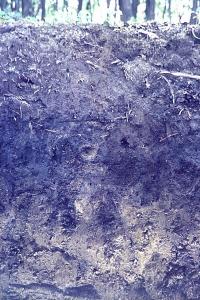Reference soil Germany 14: Luvic Chernozem
Chernozems are typically found in the long-grass steppe regions of the world, particularly in Eastern Europe and North America (Canada and the USA).
Characteristics
Soils having a very dark mollic horizon (thick, brownish or blackish surface horizon with a significant accumulation of organic matter and high base saturation) and secondary carbonates within 50 cm of the lower limit of the Ah horizon, but within 200 cm from the soil surface. They have no petrocalcic horizon between 25 and 100 cm from the soil surface, no secondary gypsum and no uncoated sand and silt grains on structural pedfaces
Reference soil DE014: Chernozem
A deep, moderately well drained silt soil profile, rich in organic matter, derived from late-Pleistocene calcareous loess. At 2 m depth sand and gravel appear. The BC horizon has got several colours (10 YR 4/3, 10 YR 6/4, 10 YR 3/2, 10 YR 2/2)). The boundaries of the horizons are often irregular due to heavy bioturbation. The soil is used for crops, mainly a rotation of sugarbeets, wheat and barley/oats. (additional climatic data: insolation (hrs))
Classification
| WRB 2014 | |||||||||||||
|---|---|---|---|---|---|---|---|---|---|---|---|---|---|
| Chernozem | |||||||||||||
|
|
|
||||||||||||
| FAO-UNESCO-ISRIC 1974 | |||||||||||||
| Luvic Chernozem | |||||||||||||
|
|
|||||||||||||
|
|||||||||||||
Niedersachsen, 4km N of Hildesheim at Harsum
